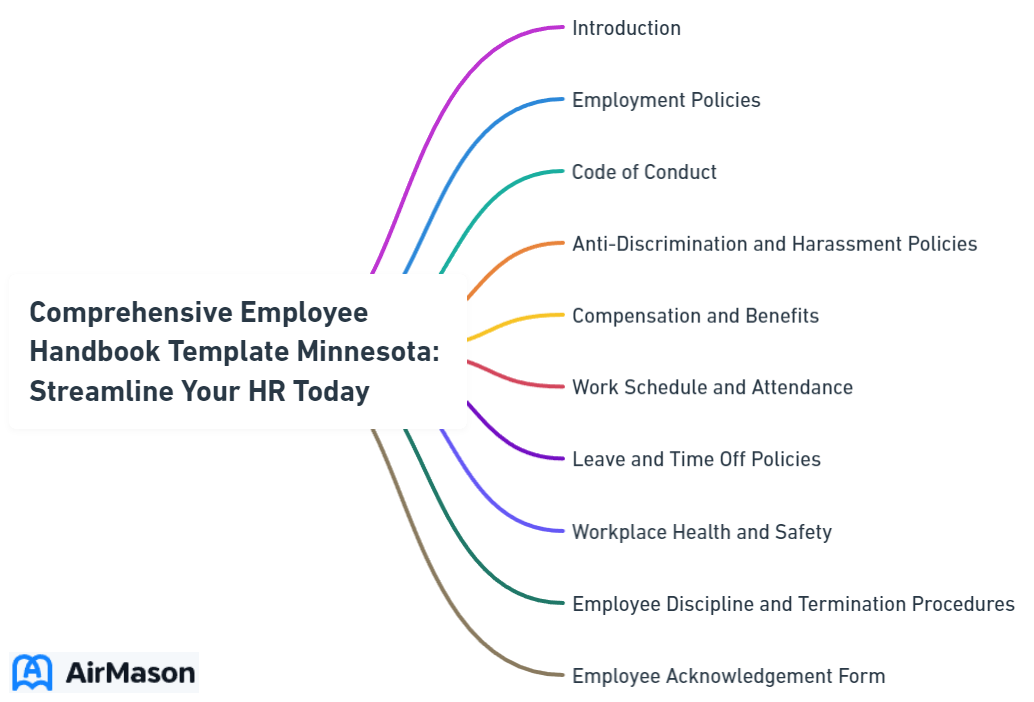
If you’re seeking an employee handbook template tailored to Minnesota’s laws, you’ve come to the right place. This article provides an actionable Employee Handbook Template Minnesota and key insights necessary for a handbook that not only meets Minnesota’s distinct legal mandates but also captures the ethos of your business.
Key Takeaways
- Employers in Minnesota must ensure that their employee handbooks not only comply with relevant federal and state laws, including specific Minnesota employment regulations, but also effectively communicate the company’s policies, culture, and values.
- It’s essential to customize employee handbooks to reflect each organization’s unique culture and values while including key policies and procedures that adhere to federal and state-specific laws, especially concerning wage and hour regulations, leave policies, and anti-discrimination and harassment laws.
- For a comprehensive Minnesota employee handbook, it’s crucial to focus on proper implementation, including distribution and training for employees, and maintain regular updates and revisions to align with changing laws and company practices, potentially leveraging digital solutions for efficiency.
Employee Handbook Additions
Employee Handbook Additions are crucial for maintaining an up-to-date and comprehensive guide for employees within an organization. These additions serve to address emerging issues, clarify existing policies, and ensure compliance with evolving regulations. Incorporating new sections or revising existing ones allows companies to adapt to changes in the workplace environment and legal landscape. Moreover, regularly updating the employee handbook fosters transparency and consistency in communication, providing employees with clear expectations and guidelines. By soliciting feedback from employees and legal counsel, organizations can tailor handbook additions to meet the specific needs and concerns of their workforce while mitigating potential risks.
Minnesota Employee Handbook Essentials
When crafting a comprehensive employee handbook, Minnesota employers should strive to meet two primary objectives: legal compliance and effective communication. The employee handbook should not only meet the minimum requirements set by the Minnesota Department of Labor and Industry, but also serve as a useful guide that clearly communicates company policies and procedures to employees.
Legal Compliance in Minnesota
Creating a Minnesota employee handbook necessitates compliance with federal and state laws. This includes labor laws, the Minnesota Fair Labor Standards Act, and the Minnesota Human Rights Act, among others. Incorporating these regulations into the handbook will safeguard businesses from potential legal disputes and ensure compliance.

Communication and Consistency
A successful employee handbook is built on the pillars of effective communication and consistency. Clear and uniform communication of policies and procedures mitigates confusion and ensures employees understand their roles and responsibilities, contributing to a positive work environment. Employee handbooks are essential tools for achieving this goal.
Creating a Customized Employee Handbook Template

The one-size-fits-all approach does not serve well when crafting an employee handbook. Each organization has its unique culture and values, and these should be reflected in the handbook.
A customized handbook resonates with employees and serves as a mirror of the company’s identity.
Identifying Key Policies and Procedures
The journey towards customization begins by identifying the key policies and procedures to include in the handbook. This involves a thorough understanding of both federal and state-specific laws, as well as the unique requirements of the organization.
Incorporating Company Culture and Values
An employee handbook should not only be a legal document but also a reflection of the company culture. Incorporating the organization’s values and mission statement in the handbook fosters unity and commitment among employees.
Addressing Unique Minnesota Employment Laws

Minnesota has specific employment laws that must be addressed in the employee handbook. These laws cover aspects such as wage and hour regulations, leave policies, and anti-discrimination and harassment laws.
A handbook that is both legally compliant and tailored to Minnesota employers’ specific needs must address these unique Minnesota laws, as well as state and federal laws, including relevant federal law.
Senior Helpers Employee Handbook
The Senior Helpers Employee Handbook serves as a comprehensive guide outlining the policies, procedures, and expectations for all employees within the organization. It covers various aspects of employment, including but not limited to, code of conduct, employee benefits, work schedules, and safety protocols. As a crucial resource, it ensures that employees understand their rights and responsibilities, fostering a productive and harmonious work environment. Regular updates to the handbook reflect any changes in company policies or regulations, ensuring compliance and clarity for all staff members. Adherence to the guidelines outlined in the Senior Helpers Employee Handbook is essential for maintaining professionalism and upholding the company’s standards of excellence.
Wage and Hour Regulations
Minnesota’s wage and hour regulations dictate the minimum wage, overtime pay, and working hours for employees. These laws are designed to ensure fair compensation and promote a healthy work-life balance. Employers need a clear understanding of these regulations to accurately outline compensation and work hours policies in the handbook.
Leave Policies
Leave policies are another crucial aspect that require careful attention. Minnesota law outlines specific regulations for parental leave, sick leave, and other forms of employee leave. The inclusion of these leave policies in the handbook clarifies employees’ rights concerning time off and enhances transparency, including the requirement to provide paid sick leave.
Anti-Discrimination and Harassment Laws
Minnesota’s anti-discrimination and harassment laws, including the Disabilities Act, aim to create a safe, inclusive work environment. These laws prohibit discrimination based on:
- race
- color
- religion
- sex/gender
- national origin
- age
- disability
- and other protected classes.
The employee handbook requirements should include federal laws along with the company’s policies designed to prevent discrimination and harassment.
Implementing and Updating Your Minnesota Employee Handbook
Once the handbook is crafted, the next steps involve effective implementation and regular updating. These processes are pivotal in maintaining the handbook’s relevance and usefulness for the employees.
Regular updates keep the handbook aligned with evolving laws and changes within the organization.
Distribution and Training
Dissemination and employee training are key to the successful implementation of the handbook. The handbook should be accessible to all employees, and training sessions should be conducted to help employees understand the contents of the handbook.
This ensures adherence to the company policies, promotes a harmonious work environment, and supports employee benefits, while maintaining health and safety standards. To inform employees about these aspects is crucial for a successful workplace.
Periodic Review and Revision
To keep the handbook current, it should undergo regular review and revision. Laws and regulations evolve, and the company’s practices may also change over time.
To maintain its relevance, the handbook should be reviewed and revised regularly.
Digital Solutions for Your Minnesota Employee Handbook

Technology, in the digital age, can be harnessed to augment the efficiency of creating, disseminating, and updating the employee handbook. Digital solutions offer a host of benefits, from easy storage and access of information to interactive elements that can make the handbook more engaging for the employees.
Employee Handbook Review
The Employee Handbook Review is a crucial process in ensuring that company policies remain relevant and compliant with current regulations. Conducting a thorough Employee Handbook Review enables organizations to identify any outdated or ambiguous policies that may need clarification or revision. Employees should actively participate in this review process to provide valuable feedback on their experiences with the existing handbook. Additionally, HR departments can collaborate with legal experts to ensure that the handbook reflects any recent changes in employment law. By regularly revisiting and updating the Employee Handbook, companies demonstrate their commitment to maintaining a fair and transparent workplace environment while mitigating potential legal risks.
Summary
In conclusion, creating a comprehensive Minnesota employee handbook is an undertaking that requires careful thought, meticulous planning, and a keen understanding of the organization’s unique culture and values. It is not merely a list of rules and regulations, but a reflection of the company’s identity and a crucial tool for fostering a positive work environment.
Frequently Asked Questions
What is required in an employee handbook in Minnesota?
In Minnesota, an employee handbook should include sections on employment policies, code of conduct, compensation, health and safety, performance expectations, and grievance procedures, as well as state-specific and federal policies. It is important to ensure that all employees are aware of the policies and rights granted to them by their state.
What is legally required in an employee handbook?
Legally, an employee handbook should cover minimum wage, overtime regulations, anti-discrimination policies, safety regulations, time off policies, social media and technology usage policies, and privacy policies. It should also include the employer’s mission statement, equal employment opportunity statement, contractual disclaimer, and at-will employment statement.
Do employers have to provide a copy of the employee handbook?
Employers are not required by law to provide a copy of the employee handbook, but it is important for informing employees of company policies and can help prevent disputes.
How to create an employee handbook?
When creating an employee handbook, make sure to include topics such as the employer’s mission statement, equal employment opportunity statement, contractual disclaimer, and purpose of the handbook. It’s also important to cover workplace policies, code of conduct, compensation, benefits, and disciplinary policies. Avoid including unnecessary policies and gather feedback throughout the process to ensure the handbook reflects company values and sets the right tone.
What are the benefits of a comprehensive employee handbook?
A comprehensive employee handbook provides guidance for employees, communicates company values, policies, and procedures, fosters a positive work environment, ensures legal compliance, and acts as a reference in case of disputes or misunderstandings. This can lead to increased productivity and a clear understanding of expectations.
Important Disclaimer:
The article presented here does not serve as a representation of the company’s actual employee handbook mentioned in this article.
Our discussions and insights regarding employee handbook are based on assumptions about what may be considered significant in the companies’ policies. These assumptions are drawn from available information and industry knowledge. Readers are advised that the content provided is for informational purposes only and should not be construed as an exact reflection of any company’s official policies or procedures. For precise and accurate details regarding a company’s employee handbook, individuals should refer directly to the company’s official documentation or consult with appropriate representatives.
Please be aware that the content on this page has been generated by using artificial intelligence language models and may contain errors, inconsistencies, or outdated information. It is provided as-is without any warranties or guarantees of accuracy. We strongly recommend using this content as a starting point for further research. We disclaim any liability for damages or losses resulting from the use or reliance on this content.